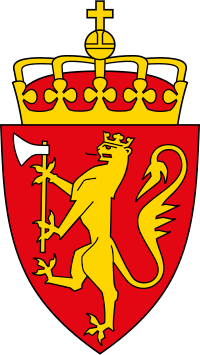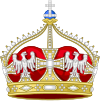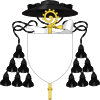| This article includes a list of general references, but it lacks sufficient corresponding inline citations. Please help to improve this article by introducing more precise citations. (June 2018) (Learn how and when to remove this message) |
| This article needs additional citations for verification. Please help improve this article by adding citations to reliable sources. Unsourced material may be challenged and removed. Find sources: "Crown" heraldry – news · newspapers · books · scholar · JSTOR (July 2024) (Learn how and when to remove this message) |

| Part of a series on |
| Heraldic achievement |
|---|
| External devices in addition to the central coat of arms |
Escutcheon
Field
Supporter
Crest
Torse
Mantling
Helmet
Crown
Compartment
Charge
Motto (or slogan)
Coat of arms

|
|
|
A crown is often an emblem of a sovereign state, usually a monarchy (see The Crown), but also used by some republics.
A specific type of crown is employed in heraldry under strict rules. Indeed, some monarchies never had a physical crown, just a heraldic representation, as in the constitutional kingdom of Belgium.
Crowns are also often used as symbols of religious status or veneration, by divinities (or their representation such as a statue) or by their representatives, e.g. the Black Crown of the Karmapa Lama, sometimes used a model for wider use by devotees.
A crown can be a charge in a coat of arms, or set atop the shield to signify the status of its owner, as with the coat of arms of Norway.
Physical and heraldic crowns
Sometimes, the crown commonly depicted and used in heraldry differs significantly from any specific physical crown that may be used by a monarchy.
 Photograph of the physical crown of Norway Photograph of the physical crown of Norway
|
 Representation of the physical crown of Norway Representation of the physical crown of Norway
|
 The heraldic crown for the King of Norway (1905 pattern) The heraldic crown for the King of Norway (1905 pattern)
|
As a display of rank
If the bearer of a coat of arms has the title of baron or higher (or hereditary knight in some countries), he or she may display a coronet of rank above the shield, usually below the helm in British heraldry, and often above the crest (if any) in Continental heraldry.
In this case, the appearance of the crown or coronet follows a strict set of rules. A royal coat of arms may display a royal crown, such as that of Norway. A princely coat of arms may display a princely crown, and so on.
Naval, civic, mural and similar crowns
A mural crown is commonly displayed on coats of arms of towns and some republics. Other republics may use a so-called people's crown or omit the use of a crown altogether. The heraldic forms of crowns are often inspired by the physical appearance of the respective country's actual royal or princely crowns.
Ships and other units of some navies have a naval crown, composed of the sails and sterns of ships, above the shield of their coats of arms. Squadrons of some air forces have an astral crown, composed of wings and stars. There is also the Eastern crown, made up of spikes, and when each spike is topped with a star, it becomes a celestial crown.
Whereas most county councils in England use mural crowns, there is a special type of crown that was used by Scottish county councils. It was composed of spikes, was normally shown vert (green) and had golden wheat sheaves between the spikes. Today, most of the Scottish unitary authorities still use this "wheat sheaf crown", but it is now the usual gold.
 Astral crown Astral crown
|
 Camp crown Camp crown
|
 Celestial crown Celestial crown
|
 Eastern crown Eastern crown
|
 Naval crown Naval crown
|
Commonwealth usage

In formal English, the word crown is reserved for the crown of a monarch and the Queen consort, whereas the word coronet is used for all other crowns used by members of the British royal family and peers of the realm.
In the British peerage, the design of a coronet shows the rank of its owner, as in German, French and various other heraldic traditions. The coronet of a duke has eight strawberry leaves, that of a marquess has four strawberry leaves and four silver balls (known as "pearls", but not actually pearls), that of an earl has eight strawberry leaves and eight "pearls" raised on stalks, that of a viscount has sixteen "pearls", and that of a peerage baron or (in Scotland) lord of parliament has six "pearls". Between the 1930s and 2004, feudal barons in the baronage of Scotland were granted a chapeau or cap of maintenance as a rank insignia. This is placed between the shield and helmet in the same manner as a peer's coronet. Since a person entitled to heraldic headgear customarily displays it above the shield and below the helm and crest, this can provide a useful clue as to the owner of a given coat of arms.
Members of the British royal family have coronets on their coats of arms, and they may wear physical versions at coronations. They are according to regulations made by King Charles II in 1661, shortly after his return from exile in France (getting a taste for its lavish court style; Louis XIV started monumental work at Versailles that year) and Restoration, and they vary depending upon the holder's relationship to the monarch. Occasionally, additional royal warrants vary the designs for individuals.
In Canadian heraldry, special coronets are used to designate descent from United Empire Loyalists. A military coronet signifies ancestors who served in Loyalist regiments during the American Revolution, while a civil coronet is used by all others. The loyalist coronets are used only in heraldry, never worn. A new royal crown, derived from the shape of the Tudor crown but with distinctly Canadian elements, was unveiled at a ceremony in Ottawa to mark the Coronation of Charles III.
 Monarch: 2024 Tudor Crown Monarch: 2024 Tudor Crown
|
 Monarch: 1901 Tudor Crown Monarch: 1901 Tudor Crown
|
 Monarch: Crown of Scotland Monarch: Crown of Scotland
|
 Monarch: Canadian Royal Crown Monarch: Canadian Royal Crown
|
 Monarch: St Edward's Crown Monarch: St Edward's Crown
|
 Monarch: Imperial Crown (medieval) Monarch: Imperial Crown (medieval)
|
 Heir Apparent Heir Apparent
|
 Child of a Sovereign (except the Heir Apparent) Child of a Sovereign (except the Heir Apparent)
|
 Child of Heir Apparent Child of Heir Apparent
|
 Grandchild of a Sovereign Grandchild of a Sovereign
|
 Child of daughter of a Sovereign, if styled Highness Child of daughter of a Sovereign, if styled Highness
|
 Duke Duke
|
 Marquess Marquess
|

|
 Viscount Viscount
|
 Peerage Baron/Lord of Parliament (Scotland) Peerage Baron/Lord of Parliament (Scotland)
|
 Loyalist military coronet (Canada) Loyalist military coronet (Canada)
|
 Loyalist civil coronet (Canada) Loyalist civil coronet (Canada)
|
 King of Arms (College of Arms) King of Arms (College of Arms)
|
Continental usages
Precisely because there are many traditions and more variation within some of these, there is a plethora of continental coronet types. Indeed, there are also some coronets for positions that do not exist, or do not entitle use of a coronet, in the Commonwealth tradition.
Such a case in French heraldry of the Ancien Régime, where coronets of rank did not come into use before the 16th century, is the vidame, whose coronet (illustrated) is a metal circle mounted with three visible crosses. (No physical headgear of this type is known.)
Helmets are often substitutes for coronets, and some coronets are worn only on a helmet.
Finland
During the Swedish reign, Swedish coronets were used. Crowns were used in the coats of arms of the historical provinces of Finland. For Finland Proper, Satakunta, Tavastia and Karelia, it was a ducal coronet; for others, a comital coronet. In 1917 with independence, the coat of arms of Finland was introduced with a grand ducal crown, but it was soon removed, in 1920. Today, some cities use coronets, e.g. Pori has a mural crown and Vaasa a Crown of Nobility.
As a charge
In heraldry, a charge is an image occupying the field of a coat of arms. Many coats of arms incorporate crowns as charges. One notable example of this lies in the Three Crowns of the arms of Sweden.
Additionally, many animal charges (frequently lions and eagles) and sometimes human heads also appear crowned. Animal charges gorged (collared) of an open coronet also occur, though more often as supporters than as charges.
Gallery
Albania
 Lord of Albania (The Skanderbeg Helmet) Lord of Albania (The Skanderbeg Helmet)
|
Andorra
Bulgaria
 Tsar Tsar
|
 Tsaritsa Tsaritsa
|
 Prince Prince
|
 Older Princesses Older Princesses
|
Croatia
 Crown of Zvonimir Crown of Zvonimir
|
France
Ancien Régime
 King King
|
 Heir to the throne (Dauphin) Heir to the throne (Dauphin)
|
(Fils de France) |
|
 Count (older) Count (older)
|
|||
Napoleonic Empire
 Emperor Emperor(1st Empire) |
 Emperor Emperor(2nd Empire) |
 Sovereign SovereignPrince |
 Prince Prince
|
 Duke Duke
|
 Count Count
|
 Baron Baron
|
 Knight Knight
|
 Bonnet d`honneur Bonnet d`honneur
|
July Monarchy
 King of the King of the French |
Georgia
 Georgian Royal Crown, also known as the "Iberian Crown" Georgian Royal Crown, also known as the "Iberian Crown"
|
German-speaking countries
Holy Roman Empire
 Imperial Crown of the Holy Roman Empire Imperial Crown of the Holy Roman Empire
|
 Older Imperial Crown Older Imperial Crown
|
 Newer Imperial Crown Newer Imperial Crown
|
|
 Older Crown of the King of the Romans Older Crown of the King of the Romans
|
 Newer Crown of the King of the Romans Newer Crown of the King of the Romans
|
 Crown of the King of Bohemia Crown of the King of Bohemia
|
 Generic Crown of a King or Grand Duke Generic Crown of a King or Grand Duke
|
 Archducal hat Archducal hat
|
 Ducal hat of Styria Ducal hat of Styria
|
 Oldest Electoral hat Oldest Electoral hat
|
 Older Electoral hat Older Electoral hat
|
 New Electoral hat & new Ducal hat New Electoral hat & new Ducal hat
|
 Ducal crown Ducal crown
|
 Crown of an heir to a duchy Crown of an heir to a duchy
|
 Princely hat (also used by Mediatized Counts Princely hat (also used by Mediatized Counts
|
 Princely crown Princely crown
|
 Crown of a Landgrave Crown of a Landgrave
|
 Older crown of a Count Older crown of a Count
|
 Newer crown of a Count Newer crown of a Count
|
 Older Crown of Nobility Older Crown of Nobility
|
 Newer Crown of Nobility Newer Crown of Nobility
|
Liechtenstein
 Prince of Liechtenstein Prince of Liechtenstein
|
Austria
 Mural crown of the coat of arms of Austria Mural crown of the coat of arms of Austria
|
Austrian Empire
 Crown of the Emperor of Austria Crown of the Emperor of Austria
|
 Crown of the King of Bohemia Crown of the King of Bohemia
|
 Archducal hat Archducal hat
|
 Archducal crown Archducal crown
|
 Ducal hat of Styria Ducal hat of Styria
|
 Ducal hat Ducal hat
|
 Ducal crown Ducal crown
|
 Princely hat Princely hat
|
 Princely crown Princely crown
|
 Crown of a Count Crown of a Count
|
 Crown of Nobility Crown of Nobility
|
Germany
German Empire
 Crown of the German Emperor Crown of the German Emperor
|
 Crown of the German Empress Crown of the German Empress
|
 Crown of the German Crown Prince Crown of the German Crown Prince
|
 Crown of the King of Prussia Crown of the King of Prussia
|
 Crown of the King of Bavaria Crown of the King of Bavaria
|
 Crown of the King of Württemberg Crown of the King of Württemberg
|
Hanover
 Crown of the King of Hanover Crown of the King of Hanover
|
Greece
 Crown of the King of the Hellenes Crown of the King of the Hellenes
|
 The Crown as it appears on the Royal Coat of Arms of Greece The Crown as it appears on the Royal Coat of Arms of Greece
|
Hungary
 Holy Crown of Hungary Holy Crown of Hungary
|
Italy
 City City
|
 Municipality Municipality
|
Kingdom of Italy (1861-1946)
 King (crown of Savoy) King (crown of Savoy)
|
 Heir to the throne (Prince of Piedmont) Heir to the throne (Prince of Piedmont)
|
 Royal prince Royal prince
|
|
 Marquess Marquess
|
|||
Kingdom of Naples, Kingdom of Sicily, Two Sicilies
 King of Naples King of Naples
|
 Heir to the throne (Duke of Calabria) Heir to the throne (Duke of Calabria)
|
 Prince and princess Prince and princess
|
Grand Duchy of Tuscany
 Medici Grand Dukes of Tuscany Medici Grand Dukes of Tuscany
|
 Habsburg-Lorraine Grand Dukes of Tuscany Habsburg-Lorraine Grand Dukes of Tuscany
|
Other Italian states before 1861
Iron Crown of Lombardy |
 Crown of San Marino |
 Crown of Napoleonic Italy |
 Doge of Venice |
 Doge of Genoa |
 Duke of Parma |
Low Countries
Netherlands
 Holy Roman Emperor Holy Roman Emperor
|
 King King
|
 Prince Prince(Members of the Royal House, children of the Monarch) |
 Prince Prince(Members of the Royal House, grandchildren of the Monarch) |
 Prince Prince(nobility, for titles granted after 1815) |
 Duke Duke
|
 Count Count
| |
 Baron Baron
|
 Hereditary Knight Hereditary Knight
|
 Jonkheer Jonkheer
|
Belgium
The older crowns are often still seen in the heraldry of older families.
 King King
|
 Prince of the Royal house Prince of the Royal house
|
 Prince Prince (nobility, for titles granted after 1815) |
 Prince Prince (nobility, for titles granted during the Ancien Régime) |
 Duke Duke
|
 Marquess Marquess
|
 Count (older) Count (older)
| |
 Count (oldest) Count (oldest)
|
 Viscount Viscount
|
 Baron (older) Baron (older)
| |
 Hereditary Knight Hereditary Knight(Chevalier/Erfridder) |
Luxembourg
 Grand Duke Grand Duke
|
Monaco
 Prince Prince
|
Montenegro
 Monarchy 1860-1918 Monarchy 1860-1918
|
 Republic 2006-Present Republic 2006-Present
|
Poland and Lithuania
 Heraldic Crown of the King Heraldic Crown of the King
|
 Crown of Bolesław I the Brave of Poland Crown of Bolesław I the Brave of Poland
|
 Grand Duke Grand Duke
|
 Prince Prince
|
 Count Count
|
 Nobleman Nobleman
|
Portugal
(1930-1999) |
Kingdom of Portugal (until 1910)
 King King
|
 Heir to the throne (Prince Royal) Heir to the throne (Prince Royal)
|
 Prince of Beira Prince of Beira
|
 Infante Infante
|
|
Romania
 Capital Capital
|
 City City
|
 Town Town
|
 village village
|
Kingdom of Romania
 King (The Steel Crown of Romania) King (The Steel Crown of Romania)
|
Russia
 Emperor Emperor
|
 Empress Empress
|
 Crown of Congress Poland Crown of Congress Poland
|
 Crown of the Grand Duchy of Finland Crown of the Grand Duchy of Finland
|
 Altabas cap Altabas cap
|
 Monomakh's Cap Monomakh's Cap
|
 Kazan cap Kazan cap
|
 Prince Prince
|
Nordic countries
Denmark
 King King
|
 Crown Prince Crown Prince
|
 Prince (royal family) Prince (royal family)
|
|
Iceland
 King King
|
Finland
 Physical crown design of the King |
 Generic Grand ducal crown used in late 19th to early 20th c. |
 Grand ducal crown used in the state coat of arms in 1917–1920. |
Ducal coronet |
Comital coronet |
Mural crown |
Norway
 Heraldic crown of the King |
 Physical crown of the King |
 Physical crown of the Queen |
 Crown Prince Crown Prince
|
 Prince or Princess Prince or Princess
|
Sweden
 King/Queen King/Queen
|
 Crown Prince/Crown Princess Crown Prince/Crown Princess
|
 Prince/Princess (aka Duke/Duchess) Prince/Princess (aka Duke/Duchess)
|
 Count/Countess Count/Countess
|
 Baron/Baroness Baron/Baroness
|
 Untitled Nobility Untitled Nobility
|
Serbia
 Emperor (medieval) Emperor (medieval)
|
 King (after 1903) King (after 1903)
|
 |
 |
Spain
 king (National arms design) king (National arms design)
|
 king (Monarch's arms design) king (Monarch's arms design)
|
 king (Aragon, Catalonia, Balearics, Valencia) king (Aragon, Catalonia, Balearics, Valencia)
|
 Heir to the throne (Prince of Asturias) Heir to the throne (Prince of Asturias)
|
 Heir to the throne (Prince of Girona) (Aragon, Catalonia, Balearics, Valencia) Heir to the throne (Prince of Girona) (Aragon, Catalonia, Balearics, Valencia)
|
 Infante Infante
|
 Infante (Aragon, Catalonia, Balearics, Valencia) Infante (Aragon, Catalonia, Balearics, Valencia)
|
 Grandee of Spain Grandee of Spain
|
 Viscount Viscount
| |||
Ukraine
 Crown of Ruthenia Crown of Ruthenia
|
Non-European usages
Bahrain
 King King
|
Bhutan
 'Raven Crown' of the Kingdom of Bhutan 'Raven Crown' of the Kingdom of Bhutan
|
Brazil
Empire of Brazil
 Emperor Emperor
|
 Heir to the throne (Prince Imperial) Heir to the throne (Prince Imperial)
|
 Prince of Grão-Pará Prince of Grão-Pará
|
 Prince Prince
|
||
Brunei
 Crown of Brunei Darussalam Crown of Brunei Darussalam
|
Cambodia
Central African Empire
 Emperor Emperor
|
Chile
 Municipal Mural Crown Municipal Mural Crown
|
 Royal Crown of Easter Island Royal Crown of Easter Island
|
China
 Emperor (Ming dynasty) Emperor (Ming dynasty)
|
 Emperor (Qing dynasty) Emperor (Qing dynasty)
|
Egypt
 Wali (1854 - 1867) and Khedive (1867–1914) Wali (1854 - 1867) and Khedive (1867–1914)
|
 Sultan (1914–22) Sultan (1914–22)
|
 King (1922–53) King (1922–53)
|
 pharaoh of Upper and Lower Egypt pharaoh of Upper and Lower Egypt
|
 Hemhem Hemhem
|
 Atef Atef
|
 King of Lower Egypt King of Lower Egypt
|
 Queen Queen
| |
 Blue Crown Blue Crown
|
 Cap Crown Cap Crown
|
Ethiopia
 Emperor Emperor
|
Fiji
 Crown of Fiji Crown of Fiji
|
Haiti
 Emperor (2nd Empire) Emperor (2nd Empire)
|
Hawaii
 Crown of Hawaii Crown of Hawaii
|
Iran
 Crown of the Shah of Persia Crown of the Shah of Persia
|
 Crown of the Shah of Iran Crown of the Shah of Iran
|
Iraq
 Crown of Iraq Crown of Iraq
|
Jordan
 Crown of Jordan Crown of Jordan
|
Libya
 Crown of Libya Crown of Libya
|
Kyrgyzstan
 Crown of Kara-Kygyz Khanate Crown of Kara-Kygyz Khanate
|
Malaysia
 sultan of Johor sultan of Johor
|
 sultan of Kelantan sultan of Kelantan
|
 sultan of Terengganu sultan of Terengganu
|
Mexico
 Emperor (1st Empire) Emperor (1st Empire)
|
 Emperor (2nd Empire) Emperor (2nd Empire)
|
 Prince (1st Empire and 2nd Empire) Prince (1st Empire and 2nd Empire)
|
Morocco
 Heraldic Crown of Morocco Heraldic Crown of Morocco
|
Nepal
 Crown of Nepal Crown of Nepal
|
Oman
 Crown of Oman Crown of Oman
|
Rwanda
 Crown of the Kingdom of Rwanda Crown of the Kingdom of Rwanda
|
Saudi Arabia
 Crown of Saudi Arabia Crown of Saudi Arabia
|
Siam and Thailand
 Great Crown of Victory of the King of Siam and Thailand Great Crown of Victory of the King of Siam and Thailand
|
 Phra Kiao (princely coronet, also the emblem of king Chulalongkorn) Phra Kiao (princely coronet, also the emblem of king Chulalongkorn)
|
 coronet of the Crown prince of Siam/Thailand coronet of the Crown prince of Siam/Thailand
|
Tahiti
 Crown of Tahiti Crown of Tahiti
|
Tonga
 Crown of Tonga Crown of Tonga
|
Other examples
Ecclesiastical Hats
Anglican Communion
 Archbishop or Bishop Archbishop or Bishop
|
 Archdeacon Archdeacon
|
 Dean Dean
|
 Members of His Majesty's Ecclesiastical Household Members of His Majesty's Ecclesiastical Household
|
 Canons, Honorary Canons, Canons Emeritus and Prebendaries Canons, Honorary Canons, Canons Emeritus and Prebendaries
|
 Priest Priest
|
 Deacon Deacon
|
Catholic Church
 Pope Pope
|
 Patriarch Patriarch
|
 Cardinal Cardinal
|
 Metropolitan Archbishop Metropolitan Archbishop
|
 Archbishop Archbishop
|
 Eastern Catholic prelate, combining elements of both Eastern and Western ecclesiastical heraldry Eastern Catholic prelate, combining elements of both Eastern and Western ecclesiastical heraldry
|
 Apostolic protonotary (Monsignor) Apostolic protonotary (Monsignor)
|
 Honorary Prelate (Monsignor) Honorary Prelate (Monsignor)
|
 Chaplain of His Holiness (Monsignor) Chaplain of His Holiness (Monsignor)
|
 Bishop Bishop
|
 Abbot Abbot
|
 Canon Canon
|
 Dean Dean
|
 Priest Priest
|
See also
Notes
- Currently, besides the younger son of the present King Charles III, the living children of a former sovereign are granted the privilege to use the crown of a Sovereign's Child; thus the King's brothers and sister also use this crown.
- Currently, besides the grandchildren of the present King Charles III, the living grandchildren of a former sovereign are granted the privilege to use the crown of a Sovereign's Grandchild.
- ^ This standard has many exceptions.
- The dukes of Genoa were granted the privilege to use the crown of a royal prince though they were only princes of the blood
References
- Mackinnon of Dunakin, Charles (1968). The Observer's Book of Heraldry. Frederick Warne & Co. Ltd. p. 73.
- Moncreiffe, Iain; Pottinger, Don (1953). Simple Heraldry Cheerfully Illustrated. Thomas Nelson and Sons. p. 58.
- Cox, Noel The Coronets of Members of the Royal Family and of the Peerage. Archived 2018-01-04 at the Wayback Machine Originally published in (1999) 22 The Double Tressure, the Journal of The Heraldry Society of Scotland 8-13. Acceded 8 April 2017
- Boutell, Charles (1914). Fox-Davies, A.C. (ed.). Handbook to English Heraldry, The (11th ed.). London: Reeves & Turner. pp. 104–156.
- Ströhl, Hugo Gerard (1899). Heraldischer Atlas. Stuttgart.
{{cite book}}: CS1 maint: location missing publisher (link)
| Types of crown | ||
|---|---|---|
| By rank |  | |
| By use | ||
| By form | ||
| Parts | ||
| Other | Wreath | |
| Heraldry | |||||||||||||||
|---|---|---|---|---|---|---|---|---|---|---|---|---|---|---|---|
| Types | |||||||||||||||
| Topics | |||||||||||||||
| Achievement | |||||||||||||||
| Charges | |||||||||||||||
| Tinctures |
| ||||||||||||||
| Applications | |||||||||||||||
| Related | |||||||||||||||
| |||||||||||||||